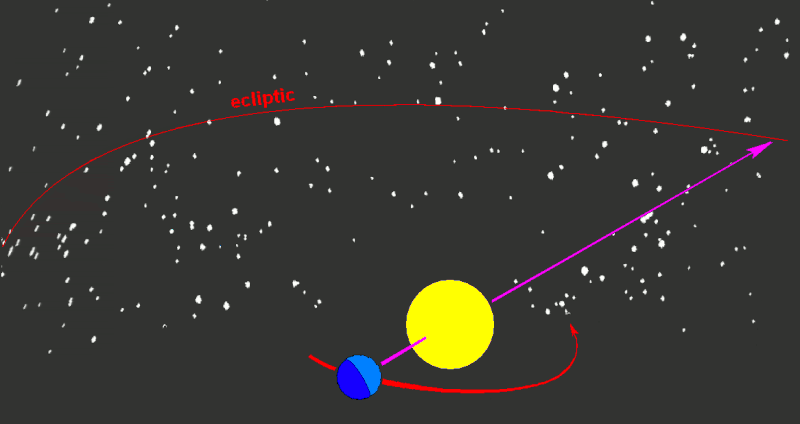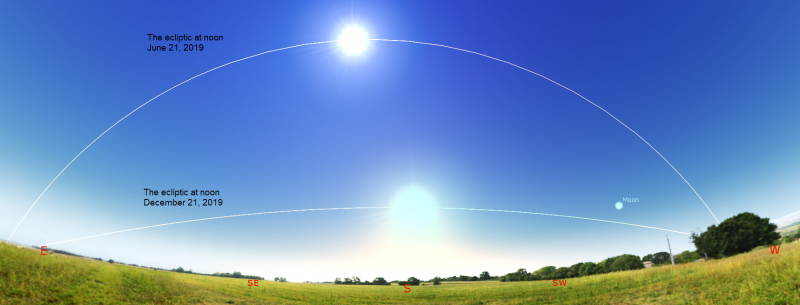
The June solstice is next week. It’ll fall at at 20:51 UTC (3:51 p.m. CDT) on Thursday, June 20, 2024. So it’s tough to miss the high path of the sun across Northern Hemisphere skies now. Or the sun’s low path as seen by our friends in the Southern Hemisphere. The sun’s path across our sky is called the ecliptic.
The ecliptic is the sun’s path
Maybe you’ve noticed that the moon and planets follow the sun’s path across your sky? Unless you live in the high Arctic or Antarctic, you see the sun arc across your sky each day from east to west. The moon follows the sun’s path as well. And so do the major planets in our solar system. This imaginary track across our sky is the ecliptic. Technically speaking, it’s a projection of the plane of Earth’s orbit around the sun, traced onto our sky. Practically speaking, the ecliptic forms a great circle around the sky and is a useful tool for stargazers.
Why do the moon and planets follow the sun’s path? It’s mainly because, long ago – before there was a solar system as we know it today – there was a vast cloud of gas and dust in space. This cloud was spinning, and, as it spun, it flattened out. Our sun formed in the center of this cloud. The major planets (including Earth) and most other solar system objects formed in the flat disk surrounding the sun. The ecliptic is this flat disk of planets in our sun’s family – our solar system – translated onto our sky.
Planets follow the ecliptic
So the major planets – and many of the minor planets, aka asteroids – orbit the sun in more or less the same plane. We can speak of this plane as defined by Earth’s orbit around the sun: the ecliptic.
If we could watch the solar system from far above the Earth’s North Pole, we’d see the planets, moons, asteroids and some of the comets (but not all of them) rushing around the sun counterclockwise in this plane, like marbles rolling around a flat dish. In fact, the major planets are more within the dish than on it. They’re within the plane of the ecliptic, more or less.
They retain the outline of the original cloud in space from which they were born, and their movement around the sun is an echo of the original spin of the cloud.

Defining the zodiac
Far beyond the cold edges of our solar system, we see the stars of our Milky Way galaxy. And the stars are moving, too, in great orbits around the galaxy’s center. But they’re so far away that they don’t seem to move over the course of a human lifespan. That’s why we refer to them as “fixed” stars.
Naturally, the fixed stars on the ecliptic – or sun’s path – seemed special to the early stargazers. So they identified constellations made of these stars, and used the word zodiac for the wider pathway traveled by these constellations. And so we find the sun, moon and our major planets within the constellations of the zodiac.
A clarification on the ecliptic
Now about that phrase we keep using, the phrase more or less …
The fact is, the other planets don’t orbit exactly in the Earth-sun plane. That’s because each major planet’s orbit is inclined a little bit to this plane. Some of the asteroids have orbits that are more inclined. And comets tend to have the most inclined orbits of all. See a chart at Wikipedia with the inclinations of the major planets’ orbits.
The moon and the ecliptic
Interestingly, Earth’s moon isn’t exactly on the ecliptic, either. Its orbit around Earth is tilted by about 5.15 degrees relative to the ecliptic. This means the moon spends most of its time above or below the ecliptic. It crosses it twice each orbit: once going upward and once downward from our point of view. Therefore, we usually see the moon close to, but not exactly alongside, the other solar system objects.
On the other hand, the moon sometimes passes right in front of other solar system objects, in an event called an occultation.
So there are little variations. But – for all practical purposes of skywatching – you can think of the ecliptic as a line across our sky. You can think of the sun, moon and major planets of the solar system as moving along that line.
The ecliptic and the season
One thing to remember, though. The sun’s path is high in summer and low in winter. So the location of the ecliptic in your sky shifts a bit, seasonally. Also, the angle of the ecliptic and how it connects to our horizon is different in spring and fall and in the evening versus the morning. See the charts below.



Ecliptic, eclipse
If the word ecliptic sounds familiar, you’re right. That’s because it’s from the same root as the word eclipse, from the Latin and Greek meaning to “fail to appear” or “to be hidden.” Of course, the moon hides the sun during an eclipse. So the ecliptic got its name because the ancients saw that solar eclipses happen when the moon crosses the ecliptic during the new moon phase.
Later, astronomers gave the name node to the places where the moon crosses the ecliptic. If the moon traveled exactly on the ecliptic, and the other planets did, too, the moon would occult, or block out, all the planets and the sun every orbit. We’d have lunar and solar eclipses every month!
Watch the sky
If you’re able, keep an eye on the sun, the moon and the planets for a while. Watch for a few days, a few weeks, months, years, even. You’ll begin to get a feel for the ecliptic in your sky. You’ll notice the planets, sun and moon are always on or near the ecliptic, and you can use this line across your sky to help you find your way around, making your way between the constellations and stars. You’ll notice the sun’s path – the ecliptic – higher in the sky during the summer months and lower during the winter.
Eventually, you’ll be able to imagine the sun’s path in your sky, long after the sun has set.
When that happens, you’ll be able to pick out a planet from a star very quickly and easily, which is a great party trick. Mars is the red one; Saturn the yellow one; Venus the bright white one that never gets too far from the sun; Mercury the seldom-seen one; and Jupiter the very bright one (but never as bright as Venus) that often gets far from the sun.
Welcome to stargazing, friend!

Bottom Line: The ecliptic is the path the sun takes across our sky. In fact, it’s the Earth-sun plane. And, more or less, it’s the plane of the orbits of the major planets and their moons, and some asteroids. Here’s a stargazing tip: Learn the whereabouts of the ecliptic in your sky. And you’ll always find the sun, moon and planets on or near it.











